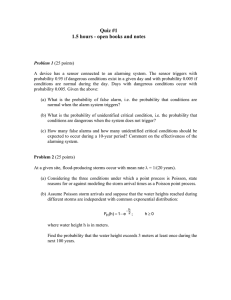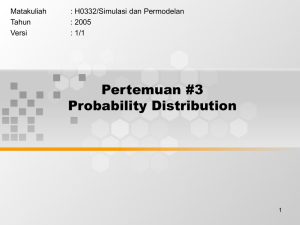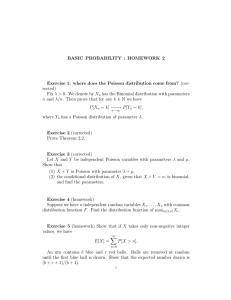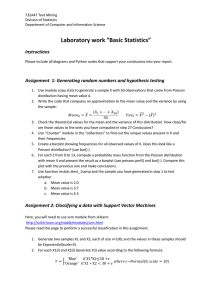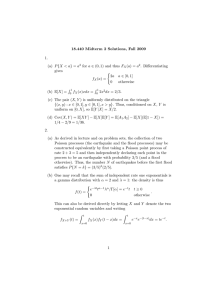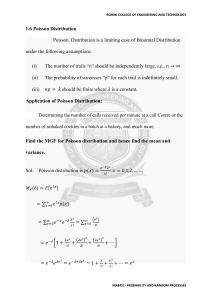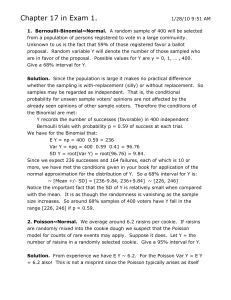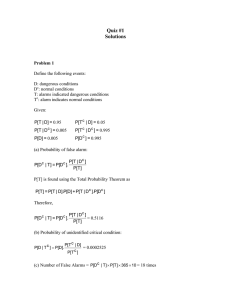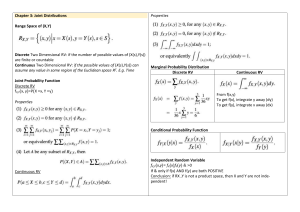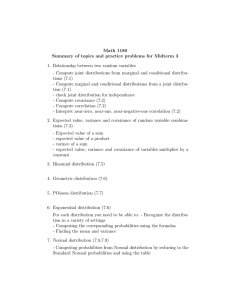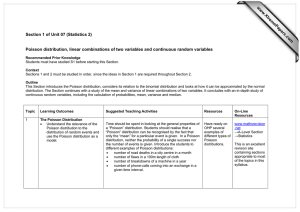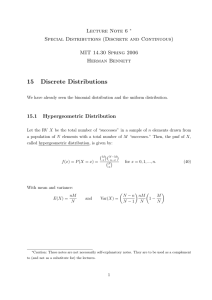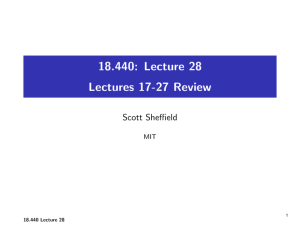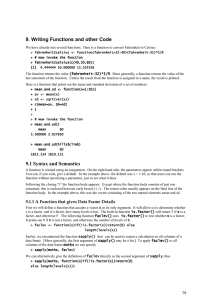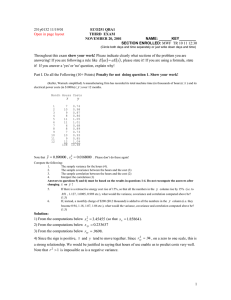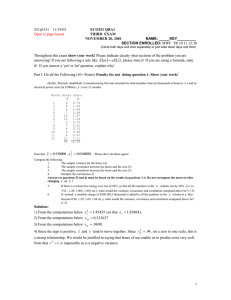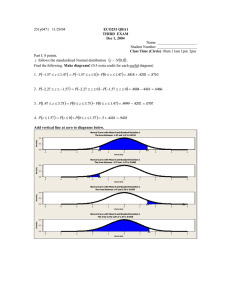5010 solutions, Assignment 9. Chapter 5: 31, 32, 33, 35,... 31. Let X , X , . . . , X
advertisement
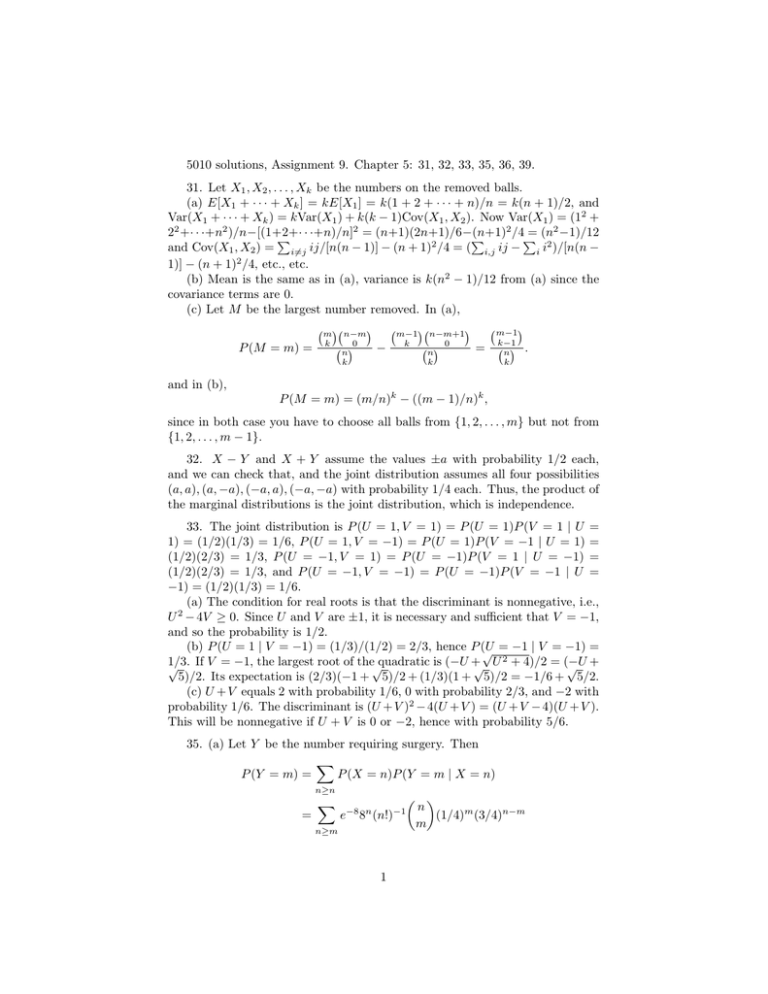
5010 solutions, Assignment 9. Chapter 5: 31, 32, 33, 35, 36, 39.
31. Let X1 , X2 , . . . , Xk be the numbers on the removed balls.
(a) E[X1 + · · · + Xk ] = kE[X1 ] = k(1 + 2 + · · · + n)/n = k(n + 1)/2, and
Var(X1 + · · · + Xk ) = kVar(X1 ) + k(k − 1)Cov(X1 , X2 ). Now Var(X1 ) = (12 +
2
2
22 +· · ·+n2 )/n−[(1+2+·
/4P
= (n2 −1)/12
P · ·+n)/n] = (n+1)(2n+1)/6−(n+1)
P
2
and Cov(X1 , X2 ) = i6=j ij/[n(n − 1)] − (n + 1) /4 = ( i,j ij − i i2 )/[n(n −
1)] − (n + 1)2 /4, etc., etc.
(b) Mean is the same as in (a), variance is k(n2 − 1)/12 from (a) since the
covariance terms are 0.
(c) Let M be the largest number removed. In (a),
m−1
m−1 n−m+1
m n−m
P (M = m) =
k
n
k
0
k
−
0
n
k
=
k−1
n
k
.
and in (b),
P (M = m) = (m/n)k − ((m − 1)/n)k ,
since in both case you have to choose all balls from {1, 2, . . . , m} but not from
{1, 2, . . . , m − 1}.
32. X − Y and X + Y assume the values ±a with probability 1/2 each,
and we can check that, and the joint distribution assumes all four possibilities
(a, a), (a, −a), (−a, a), (−a, −a) with probability 1/4 each. Thus, the product of
the marginal distributions is the joint distribution, which is independence.
33. The joint distribution is P (U = 1, V = 1) = P (U = 1)P (V = 1 | U =
1) = (1/2)(1/3) = 1/6, P (U = 1, V = −1) = P (U = 1)P (V = −1 | U = 1) =
(1/2)(2/3) = 1/3, P (U = −1, V = 1) = P (U = −1)P (V = 1 | U = −1) =
(1/2)(2/3) = 1/3, and P (U = −1, V = −1) = P (U = −1)P (V = −1 | U =
−1) = (1/2)(1/3) = 1/6.
(a) The condition for real roots is that the discriminant is nonnegative, i.e.,
U 2 − 4V ≥ 0. Since U and V are ±1, it is necessary and sufficient that V = −1,
and so the probability is 1/2.
(b) P (U = 1 | V = −1) = (1/3)/(1/2) = 2/3, hence P (U
√ = −1 | V = −1) =
2
1/3.
If
V
=
−1,
the
largest
root
of
the
quadratic
is
(−U
+
√
√
√ U + 4)/2 = (−U
√ +
5)/2. Its expectation is (2/3)(−1 + 5)/2 + (1/3)(1 + 5)/2 = −1/6 + 5/2.
(c) U + V equals 2 with probability 1/6, 0 with probability 2/3, and −2 with
probability 1/6. The discriminant is (U + V )2 − 4(U + V ) = (U + V − 4)(U + V ).
This will be nonnegative if U + V is 0 or −2, hence with probability 5/6.
35. (a) Let Y be the number requiring surgery. Then
X
P (Y = m) =
P (X = n)P (Y = m | X = n)
n≥n
=
X
−8 n
e
−1
8 (n!)
n≥m
1
n
(1/4)m (3/4)n−m
m
= e−8 3−m (m!)−1
X
8n (3/4)n /(n − m)!
n≥m
−8 −m
−1 m 6
= e 3 (m!) 6 e
= e−2 2−m (m!)−1 ,
which is Poisson(2), whose mean is 2.
(b) Replace 8 by 4 to get Poisson(1) for weekends. For the week, we have 5
days with Poisson(2) and 2 days of Poisson(1). Total is Poisson(12), which has
mean and variance 12.
36. This is the hypergeometric distribution. The mean is E[X1 +· · ·+Xn ] =
nE[X1 ] = nm/M , and the variance is nVar(X1 ) + n(n − 1)Cov(X1 , X2 ) =
n(m/M )(1 − m/M ) + n(n − 1){m(m − 1)/[M (M − 1)] − (m/M )2 }, which can
be simplified slightly.
39. (a)
P (X1 < X2 < X3 ) =
∞
∞ X
X
∞
X
P (X1 = i, X2 = j, X3 = k)
i=1 j=i+1 k=j+1
=
∞
∞ X
X
∞
X
j−1
k−1
pi−1
(1 − p3 )
1 (1 − p1 )p2 (1 − p2 )p3
i=1 j=i+1 k=j+1
=
∞ X
∞
X
j−1
j
pi−1
1 (1 − p1 )p2 (1 − p2 )p3
i=1 j=i+1
=
∞
∞ X
X
j−1
pi−1
(1 − p2 )p3
1 (1 − p1 )(p2 p3 )
i=1 j=i+1
=
∞
X
i
pi−1
1 (1 − p1 )(p2 p3 ) (1 − p2 )p3 /(1 − p2 p3 )
i=1
=
∞
X
(p1 p2 p3 )i−1 (1 − p1 )(1 − p2 )p2 p23 /(1 − p2 p3 )
i=1
= (1 − p1 )(1 − p2 )p2 p23 /[(1 − p2 p3 )(1 − p1 p2 p3 )],
(b)
P (X1 ≤ X2 ≤ X3 ) =
=
=
∞ X
∞ X
∞
X
i=1 j=i k=j
∞ X
∞ X
∞
X
P (X1 = i, X2 = j, X3 = k)
j−1
k−1
(1 − p3 )
pi−1
1 (1 − p1 )p2 (1 − p2 )p3
i=1 j=i k=j
∞ X
∞
X
pi−1
1 (1
i=1 j=i
2
j−1
− p1 )pj−1
2 (1 − p2 )p3
=
∞ X
∞
X
j−1
pi−1
(1 − p2 )
1 (1 − p1 )(p2 p3 )
i=1 j=i
=
∞
X
i−1
pi−1
(1 − p2 )/(1 − p2 p3 )
1 (1 − p1 )(p2 p3 )
i=1
=
∞
X
(p1 p2 p3 )i−1 (1 − p1 )(1 − p2 )/(1 − p2 p3 )
i=1
= (1 − p1 )(1 − p2 )/[(1 − p2 p3 )(1 − p1 p2 p3 )],
(c) The probability A throws 6 first, B second, and C third is just the answer
to part (b) with p1 = p2 = p3 = 5/6. We get
(1/6)(1/6)/[(1 − 25/36)(1 − 125/216)] = 216/1001.
3
